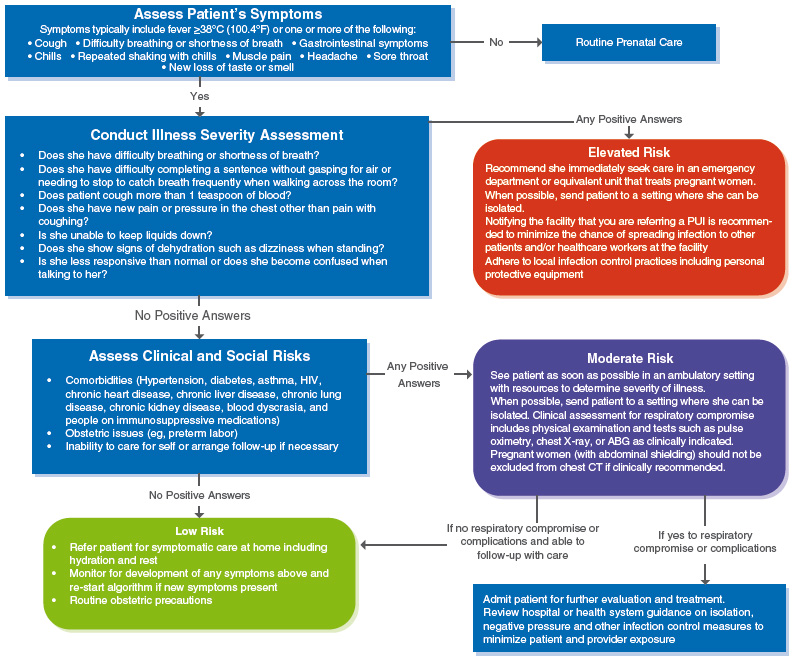Services on Demand
Journal
Article
Indicators
-
 Cited by SciELO
Cited by SciELO
Related links
-
 Similars in
SciELO
Similars in
SciELO
Share
Revista Peruana de Ginecología y Obstetricia
On-line version ISSN 2304-5132
Rev. peru. ginecol. obstet. vol.66 no.2 Lima Apr-Jun 2020
Algorithm
Outpatient Assessment and Management for Pregnant Women With Suspected or Confirmed Novel Coronavirus (COVID-19)
Unlike influenza and other respiratory illnesses, based on a limited number of confirmed COVID-19 cases, pregnant women do not appear to be at increased risk for severe disease. However, given the lack of data and experience with other coronaviruses such as SARS-CoV and MERS-CoV, diligence in evaluating and treating pregnant women is warranted.
This algorithm is designed to aid practitioners in promptly evaluating and treating pregnant persons with known exposure and/or those with symptoms consistent with COVID-19 (persons under investigation [PUI]). If influenza viruses are still circulating, influenza may be a cause of respiratory symptoms and practitioners are encouraged to use the ACOG/SMFM influenza algorithm to assess need for influenza treatment or prophylaxis.
Please be advised that COVID-19 is a rapidly evolving situation and this guidance may become out-of-date as new information on COVID-19 in pregnant women becomes available from the Centers for Disease Control and Prevention (CDC). https://www. cdc.gov/coronavirus/2019-nCoV/index.html
Abbreviations: ABG, arterial blood gases; CDC, Centers for Disease Control and Prevention; HIV, human immunodeficiency virus.
Healthcare providers should immediately notify their local or state health department in the event of a PUI for COVID-19 and should contact and consult with their local and/or state health department for recommendations on testing PUIs for COVID-19.
This information is designed as an educational resource to aid clinicians in providing obstetric and gynecologic care, and use of this information is voluntary. This information should not be considered as inclusive of all proper treatments or methods of care or as a statement of the standard of care. It is not intended to substitute for the independent professional judgment of the treating clinician. Variations in practice may be warranted when, in the reasonable judgment of the treating clinician, such course of action is indicated by the condi-tion of the patient, limitations of available resources, or advances in knowledge or technology. The American College of Obstetricians and Gynecologists reviews its publications regularly; however, its publications may not reflect the most recent evidence. Any updates to this document can be found on www.acog.org or by calling the ACOG Resource Center. While ACOG makes every effort to present accurate and reliable information, this publication is provided "as is" without any warranty of accuracy, reliability, or otherwise, either express or implied. ACOG does not guarantee, warrant, or endorse the products or services of any firm, organization, or person. Neither ACOG nor its officers, directors, members, employees, or agents will be liable for any loss, damage, or claim with respect to any liabilities, including direct, special, indirect, or consequential damages, incurred in connection with this publication or reliance on the information presented.
Copyright 2020 American College of Obstetricians and Gynecologists
Revised: April 30, 2020











 text in
text in 



